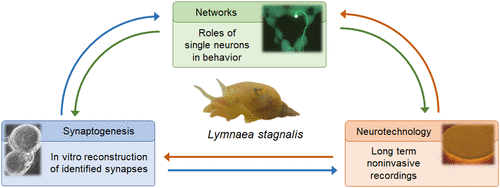当前位置:
X-MOL 学术
›
ACS Chem. Neurosci.
›
论文详情
Our official English website, www.x-mol.net, welcomes your
feedback! (Note: you will need to create a separate account there.)
Uncovering the Cellular and Molecular Mechanisms of Synapse Formation and Functional Specificity Using Central Neurons of Lymnaea stagnalis
ACS Chemical Neuroscience ( IF 4.1 ) Pub Date : 2018-03-12 00:00:00 , DOI: 10.1021/acschemneuro.7b00448 Angela M. Getz 1, 2 , Pierre Wijdenes 1, 3 , Saba Riaz 1 , Naweed I. Syed 1
ACS Chemical Neuroscience ( IF 4.1 ) Pub Date : 2018-03-12 00:00:00 , DOI: 10.1021/acschemneuro.7b00448 Angela M. Getz 1, 2 , Pierre Wijdenes 1, 3 , Saba Riaz 1 , Naweed I. Syed 1
Affiliation

|
All functions of the nervous system are contingent upon the precise organization of neuronal connections that are initially patterned during development, and then continually modified throughout life. Determining the mechanisms that specify the formation and functional modulation of synaptic circuitry are critical to advancing both our fundamental understanding of the nervous system as well as the various neurodevelopmental, neurological, neuropsychiatric, and neurodegenerative disorders that are met in clinical practice when these processes go awry. Defining the cellular and molecular mechanisms underlying nervous system development, function, and pathology has proven challenging, due mainly to the complexity of the vertebrate brain. Simple model system approaches with invertebrate preparations, on the other hand, have played pivotal roles in elucidating the fundamental mechanisms underlying the formation and plasticity of individual synapses, and the contributions of individual neurons and their synaptic connections that underlie a variety of behaviors, and learning and memory. In this Review, we discuss the experimental utility of the invertebrate mollusc Lymnaea stagnalis, with a particular emphasis on in vitro cell culture, semi-intact and in vivo preparations, which enable molecular and electrophysiological identification of the cellular and molecular mechanisms governing the formation, plasticity, and specificity of individual synapses at a single-neuron or single-synapse resolution.
中文翻译:

揭示了使用剑兰中枢神经元的突触形成和功能特异性的细胞和分子机制。
神经系统的所有功能都取决于神经元连接的精确组织,神经元连接在发育过程中首先被图案化,然后在整个生命中不断地被改变。确定指定突触回路形成和功能调节的机制对于增进我们对神经系统以及临床实践中遇到的各种神经发育,神经系统,神经精神病学和神经退行性疾病的基本认识是至关重要的。 。主要由于脊椎动物大脑的复杂性,界定神经系统发育,功能和病理的细胞和分子机制已被证明具有挑战性。另一方面,简单模型系统采用无脊椎动物的方法,在阐明个体突触的形成和可塑性的基础机制以及个体神经元的贡献及其构成各种行为,学习和记忆的突触连接方面发挥了关键作用。在这篇评论中,我们讨论了无脊椎动物软体动物的实验效用鼠李(Lymnaea stagnalis),特别着重于体外细胞培养,半完整和体内制剂,这使分子和电生理学鉴定控制单个神经元或单个神经元突触的形成,可塑性和特异性的细胞和分子机制成为可能。单突触解析。
更新日期:2018-03-12
中文翻译:

揭示了使用剑兰中枢神经元的突触形成和功能特异性的细胞和分子机制。
神经系统的所有功能都取决于神经元连接的精确组织,神经元连接在发育过程中首先被图案化,然后在整个生命中不断地被改变。确定指定突触回路形成和功能调节的机制对于增进我们对神经系统以及临床实践中遇到的各种神经发育,神经系统,神经精神病学和神经退行性疾病的基本认识是至关重要的。 。主要由于脊椎动物大脑的复杂性,界定神经系统发育,功能和病理的细胞和分子机制已被证明具有挑战性。另一方面,简单模型系统采用无脊椎动物的方法,在阐明个体突触的形成和可塑性的基础机制以及个体神经元的贡献及其构成各种行为,学习和记忆的突触连接方面发挥了关键作用。在这篇评论中,我们讨论了无脊椎动物软体动物的实验效用鼠李(Lymnaea stagnalis),特别着重于体外细胞培养,半完整和体内制剂,这使分子和电生理学鉴定控制单个神经元或单个神经元突触的形成,可塑性和特异性的细胞和分子机制成为可能。单突触解析。











































 京公网安备 11010802027423号
京公网安备 11010802027423号